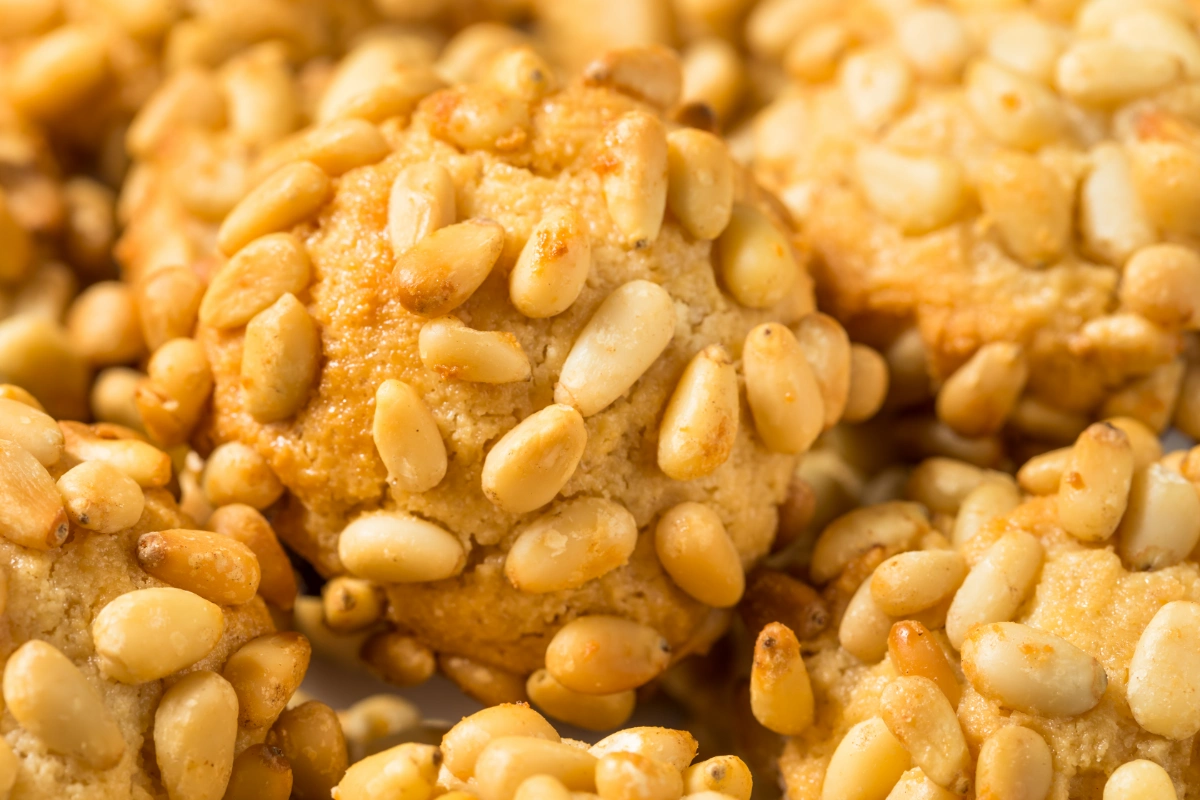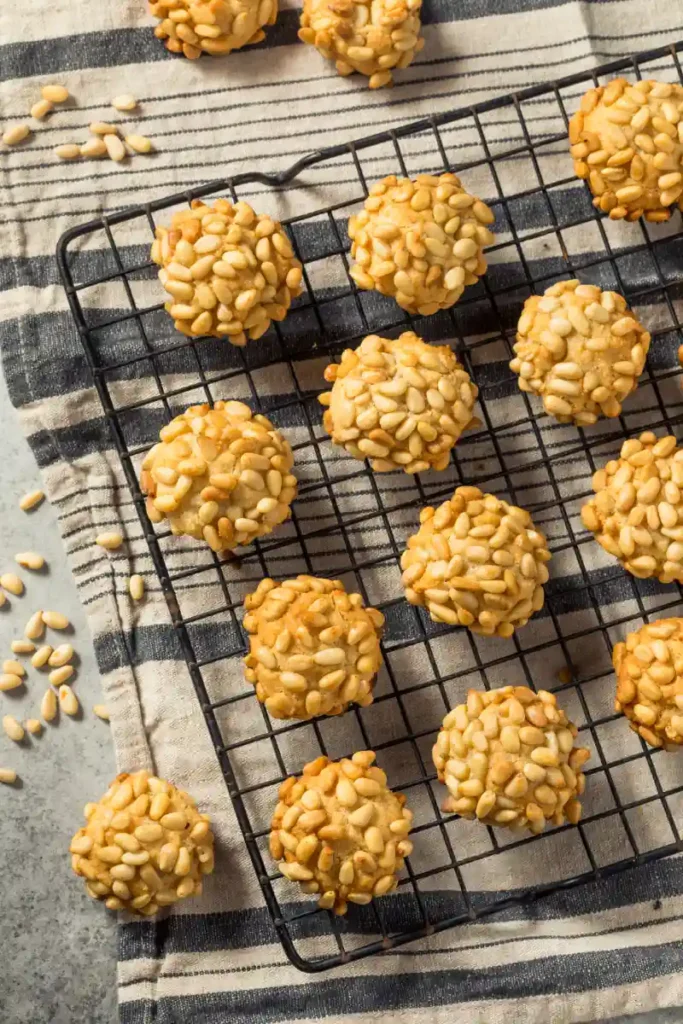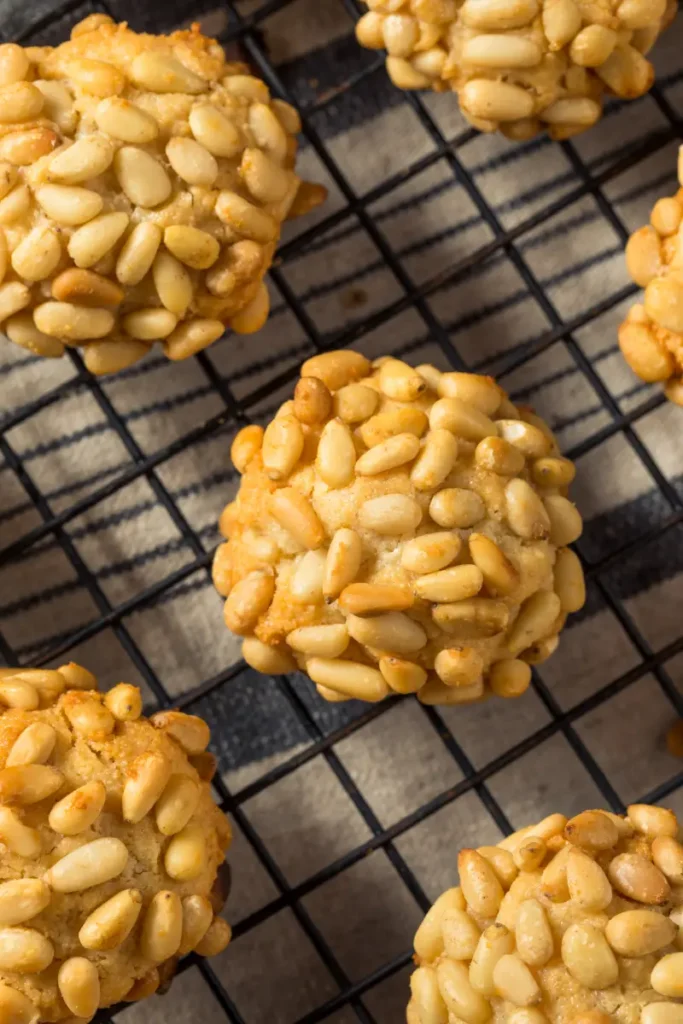Few things evoke the warmth and richness of Italian cuisine quite like pignoli cookies. These delightful treats, with their delicate almond flavor and signature pine nut topping, have captured the hearts and palates of dessert enthusiasts worldwide. Join us on a journey as we delve into the history, ingredients, and techniques behind these iconic cookies, offering tips and variations to help you create your batch of pignoli cookie perfection.
Pignoli Cookies: An Italian Delight
What are Pignoli Cookies?
Pignoli cookies, also known as pine nut cookies, are a cherished Italian delicacy with a rich history. Their origins can be traced back to Southern Italy, particularly Sicily, where they have been a staple in traditional baking for centuries. The name “pignoli” itself derives from the Italian word for pine nuts, which are the star ingredient of these delectable treats.
These cookies typically feature a soft and chewy almond paste base, generously adorned with toasted pine nuts. The combination of almond and pine nuts creates a unique and irresistible flavor profile, making pignoli cookies a true delight for the senses. Their appearance is just as captivating, with a golden brown exterior and a dusting of powdered sugar that adds a touch of elegance.
Making Pignoli Cookies at Home
Creating your batch of pignoli cookies is a rewarding experience that allows you to savor the authentic flavors of Italy in your kitchen. To embark on this culinary adventure, you’ll need a few essential tools and ingredients.
Essential Equipment:
- Mixing bowls
- Electric mixer
- Baking sheets
- Parchment paper
- Cookie scoop or spoon
Gathering Ingredients:
- Almond paste
- Sugar
- Eggs
- Pine nuts
- Confectioners’ sugar (for dusting)
Step-by-Step Instructions:
- Begin by breaking down the almond paste into smaller pieces. This will make it easier to combine with the other ingredients.
- In a mixing bowl, cream together the almond paste and sugar until well blended.
- Gradually add the eggs, one at a time, mixing well after each addition. The dough should be smooth and pliable.
- Using a cookie scoop or spoon, portion out the dough into small balls, roughly the size of a walnut.
- Roll each ball between your palms to create a smooth, round shape.
- Place the dough balls onto a baking sheet lined with parchment paper, leaving some space between them for spreading.
- Gently press pine nuts onto the surface of each dough ball, ensuring they adhere well. You can use as many or as few pine nuts as you desire, but a generous coating is traditional.
- For a more even distribution, you can roll the dough balls in a shallow dish filled with pine nuts.
- Preheat your oven to 325°F (165°C).
- Bake the cookies for approximately 15-20 minutes, or until they turn a light golden brown. Keep a close eye on them, as they can brown quickly.
- Once baked, remove the cookies from the oven and allow them to cool on the baking sheet for a few minutes before transferring them to a wire rack to cool completely.
- As the cookies cool, they will firm up slightly, achieving that perfect balance of chewy and soft texture.
- Once completely cool, dust the pignoli cookies with confectioners’ sugar for an extra touch of sweetness and visual appeal.
- Store the cookies in an airtight container at room temperature to maintain their freshness.
Variations and Serving Suggestions
Flavor Variations
While the classic pignoli cookie recipe is undeniably delicious, there’s always room for creativity and exploration in the kitchen. Here are a few flavor variations to consider:
- Citrus Zest: Adding a touch of lemon or orange zest to the dough can brighten the flavor profile of pignoli cookies, infusing them with a refreshing citrusy note. This subtle twist complements the almond and pine nut flavors beautifully.
- Spices and Extracts: For those who enjoy a bit more depth and warmth, consider incorporating spices like cinnamon or nutmeg into the dough. Alternatively, a hint of almond extract can enhance the existing almond flavor, creating a more pronounced taste experience.
- Chocolate Dipped: For an extra decadent treat, dip cooled pignoli cookies in melted chocolate. Dark, milk, or white chocolate all work well, depending on your preference. The contrast between the nutty cookie and the smooth chocolate creates a delightful combination of textures and flavors.
Serving and Enjoying Pignoli Cookies
Pignoli cookies are versatile treats that can be enjoyed in various settings and occasions. They make a delightful accompaniment to a warm cup of coffee or tea, offering a sweet and satisfying ending to a meal. Additionally, their elegant appearance and rich flavor make them a popular choice for holiday gatherings and special celebrations.
The tradition of gifting pignoli cookies is also a cherished one. Presenting a beautifully arranged box of these homemade treats to friends and family is a heartfelt gesture that conveys warmth and appreciation. Whether enjoyed as a personal indulgence or shared with loved ones, pignoli cookies bring a touch of Italian charm to any occasion.
Troubleshooting Common Issues
Even with the best intentions and a carefully followed recipe, baking can sometimes present unexpected challenges. Here are some common issues you might encounter when making pignoli cookies and how to address them:
- Cookies Spreading Too Much: If your pignoli cookies spread excessively during baking, it could be due to the dough being too soft or the oven temperature being too low. To prevent spreading, ensure your dough is chilled before baking and double-check that your oven is at the correct temperature. Using parchment paper on your baking sheets can also help.
- Pine Nuts Falling Off: To ensure the pine nuts stay securely attached to your cookies, press them firmly into the dough before baking. You can also lightly brush the dough balls with a bit of egg white or water before rolling them in the pine nuts for extra adhesion.
- Cookies Burning on the Bottom: If the bottoms of your cookies are browning too quickly, your baking sheets might be too thin or your oven temperature might be too high. Try using thicker baking sheets or lowering the oven temperature slightly. You can also place an additional baking sheet underneath the one you’re using to create a buffer and prevent excessive heat from reaching the bottom of the cookies.
Exploring the World of Pine Nuts
Pine nuts, the defining ingredient of pignoli cookies, are more than just a delicious topping. They come from various species of pine trees and offer a unique flavor and nutritional profile. Let’s delve deeper into the world of pine nuts:
- Varieties of Pine Nuts: Pine nuts are harvested from the cones of pine trees, and different species produce pine nuts with varying sizes, flavors, and textures. Some popular varieties include the Italian stone pine, the Chinese nut pine, and the Korean pine. Each type has its distinct characteristics, influencing the overall taste and quality of pignoli cookies.
- Nutritional Value: Pine nuts are a good source of healthy fats, protein, and various vitamins and minerals. They are particularly rich in magnesium, zinc, and vitamin E, which contribute to overall health and well-being. However, it’s important to note that pine nuts are also high in calories, so moderation is key.
- Culinary Uses: Beyond their starring role in pignoli cookies, pine nuts are versatile ingredients used in various cuisines around the world. They add a delightful crunch and nutty flavor to salads, pasta dishes, pesto sauces, and even desserts like baklava.
Pignoli Cookies in Italian Culture
Pignoli cookies hold a special place in Italian culture, often associated with holidays, family gatherings, and cherished traditions. Their presence on the dessert table signifies celebration and togetherness, creating lasting memories for generations.
- Holiday Traditions: Pignoli cookies are a staple during Christmas and other festive occasions in many Italian households. Their elegant appearance and delicate flavors make them a perfect addition to holiday cookie platters and dessert spreads. The act of baking and sharing pignoli cookies is a way to express love, gratitude, and the joy of the season.
- Regional Variations: While the basic recipe for pignoli cookies remains consistent throughout Italy, there might be slight regional variations in terms of ingredients and preparation methods. Some regions may use a different type of almond paste or incorporate local flavors and spices, adding a unique touch to their pignoli cookies.
- Symbolism and Significance: In Italian culture, food plays a significant role in expressing love, hospitality, and cultural identity. Pignoli cookies, with their rich history and connection to family traditions, embody these values and serve as a reminder of the importance of shared experiences and cultural heritage.
FAQs about Pignoli Cookies
Baking pignoli cookies can sometimes lead to questions and challenges, especially for first-time bakers. Here are answers to some frequently asked questions to help you achieve pignoli cookie perfection:
What are Pignoli cookies made of?
- Pignoli cookies are primarily made with almond paste, sugar, egg whites, and pine nuts. These simple ingredients come together to create a delightful treat with a soft and chewy texture and a delicate nutty flavor.
Are pignoli nuts the same as pine nuts?
- Yes, “pignoli” is simply the Italian word for pine nuts. So, pignoli nuts and pine nuts are the same thing – the edible seeds of certain pine tree species.
Why are my pignoli cookies chewy?
- The chewy texture of pignoli cookies comes from the combination of almond paste and the correct baking technique. Almond paste, with its dense and slightly sticky consistency, contributes to the chewiness, while careful baking ensures the cookies remain soft and moist on the inside.
What is the most popular Italian cookie?
- While pignoli cookies are certainly a beloved Italian treat, determining the absolute “most popular” Italian cookie is subjective and can vary based on regional preferences and personal tastes. Other popular contenders include biscotti, amaretti, and pizzelle, each offering unique flavors and textures that have captured the hearts of cookie lovers worldwide.
What can I substitute for almond paste?
- If you have nut allergies or simply prefer a different flavor, there are a few alternatives you can use. Marzipan, which is similar to almond paste but with a higher sugar content, can be a suitable substitute. Additionally, you could explore using cashew paste or sunflower seed paste for a nut-free option.
Can I freeze pignoli cookie dough?
- Absolutely! Pignoli cookie dough freezes beautifully. Simply shape the dough into balls, coat them with pine nuts, and place them on a baking sheet lined with parchment paper. Freeze the dough balls until solid, then transfer them to a freezer-safe container or bag. When you’re ready to bake, thaw the dough balls in the refrigerator overnight before baking as directed.
Why are my pignoli cookies dry?
- Dry pignoli cookies can result from overbaking or using too much flour. To ensure a chewy texture, avoid overmixing the dough and be mindful of the baking time. If your dough seems dry, you can add a small amount of water or almond extract to improve its consistency.
How long do pignoli cookies stay fresh?
- When stored properly in an airtight container at room temperature, pignoli cookies can stay fresh for up to a week. However, their texture and flavor are best enjoyed within the first few days after baking. If you need to store them for a longer period, consider freezing the baked cookies and thawing them as needed.
The Joy of Baking Pignoli Cookies
Baking pignoli cookies is more than just following a recipe; it’s a journey of creativity, tradition, and sensory delight. The process of measuring ingredients, mixing the dough, shaping the cookies, and carefully placing the pine nuts creates a sense of anticipation and satisfaction. The aroma that fills the kitchen as the cookies bake is an irresistible invitation to gather and indulge in these sweet treats.
Whether you’re a seasoned baker or a novice in the kitchen, pignoli cookies offer an opportunity to connect with Italian culture, explore new flavors, and create something special to share with loved ones. So, gather your ingredients, put on your apron, and embark on the delightful adventure of baking pignoli cookies – a taste of Italy that will surely leave a lasting impression.
More Delicious Recipes:
- Bishop Cake: Experience the divine fusion of flavors with our Bishop Cake recipe. Moist, fruity, and utterly delicious, this dessert is a true crowd-pleaser. Follow our simple instructions to bake up a slice of heaven in your own kitchen.
- Panda Express Honey Sesame Chicken: Savor the bold flavors of Asia with our Panda Express Honey Sesame Chicken recipe. Tender chicken glazed in a sweet and savory sauce, this dish is a culinary adventure waiting to happen. Whip it up at home with ease using our foolproof recipe.




2 thoughts on “Pignoli Cookies: Italian Almond & Pine Nut Delights”